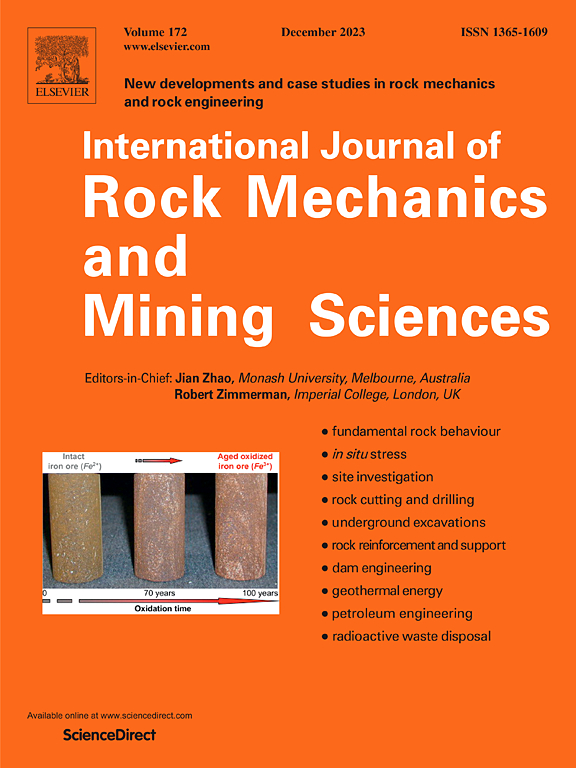Hydro-mechanical insights for radioactive waste disposal from gas injection experiments in shale
IF 7
1区 工程技术
Q1 ENGINEERING, GEOLOGICAL
International Journal of Rock Mechanics and Mining Sciences
Pub Date : 2025-02-01
DOI:10.1016/j.ijrmms.2025.106039
引用次数: 0
Abstract
Disposal of radioactive waste in deep geological repositories relies on the integrity of geological barriers, where gas migration can compromise long-term safety. This study examines the hydro-mechanical response of a shale under varying gas pressure build-up rates, using gas injection tests conducted in a high-pressure oedometer cell to simulate in-situ stress conditions. The research highlights that gas-induced porewater redistribution plays a key role during gas invasion processes. Results indicate that rapid gas pressure build-up leads to undrained conditions associated with significant porewater pressure development and expansive strains, while slower gas injection results in a drained response with less deformation. Additionally, a delayed gas breakthrough during rapid pressure build-up suggests the impedance of gas movement by porewater. However, once steady-state is achieved, both tests converge to similar gas flow rates and equilibrium states, indicating that the long-term gas transport properties of Opalinus Clay, selected as the host geomaterial for the Swiss repository, are not significantly influenced by initial gas pressure rates. Furthermore, neither the water intrinsic permeability nor the pore size distribution of the material is altered by gas invasion, highlighting the robustness of Opalinus Clay as a geological barrier for radioactive waste disposal. These findings emphasize the importance of understanding both short-term and long-term hydro-mechanical responses of shales subjected to gas transport to ensure the long-term containment and isolation of radioactive waste.
页岩注气实验中放射性废物处理的流体力学见解
在深层地质储存库中处置放射性废物依赖于地质屏障的完整性,在这些地质屏障中,气体迁移可能会危及长期安全。该研究考察了页岩在不同气体压力积累速率下的流体力学响应,在高压压力计单元中进行了注气测试,以模拟地应力条件。研究表明,气致孔隙水再分配在气侵过程中起着关键作用。结果表明,快速的气体压力积累会导致不排水条件,并伴有显著的孔隙水压力发展和膨胀应变,而较慢的气体注入会导致排水响应,且变形较小。此外,在快速压力积聚过程中,延迟的气体突破表明孔隙水对气体运动的阻碍。然而,一旦达到稳态,两个测试都收敛到相似的气体流速和平衡状态,这表明Opalinus粘土(被选为瑞士储库的宿主岩土材料)的长期气体输送特性不受初始气体压力速率的显著影响。此外,无论是水的固有渗透率还是材料的孔径分布都不会因气体入侵而改变,这突出了蛋白石粘土作为放射性废物处置地质屏障的坚固性。这些发现强调了了解页岩在天然气输送过程中的短期和长期流体力学响应的重要性,以确保放射性废物的长期遏制和隔离。
本文章由计算机程序翻译,如有差异,请以英文原文为准。
求助全文
约1分钟内获得全文
求助全文
来源期刊
CiteScore
14.00
自引率
5.60%
发文量
196
审稿时长
18 weeks
期刊介绍:
The International Journal of Rock Mechanics and Mining Sciences focuses on original research, new developments, site measurements, and case studies within the fields of rock mechanics and rock engineering. Serving as an international platform, it showcases high-quality papers addressing rock mechanics and the application of its principles and techniques in mining and civil engineering projects situated on or within rock masses. These projects encompass a wide range, including slopes, open-pit mines, quarries, shafts, tunnels, caverns, underground mines, metro systems, dams, hydro-electric stations, geothermal energy, petroleum engineering, and radioactive waste disposal. The journal welcomes submissions on various topics, with particular interest in theoretical advancements, analytical and numerical methods, rock testing, site investigation, and case studies.

 求助内容:
求助内容: 应助结果提醒方式:
应助结果提醒方式:


